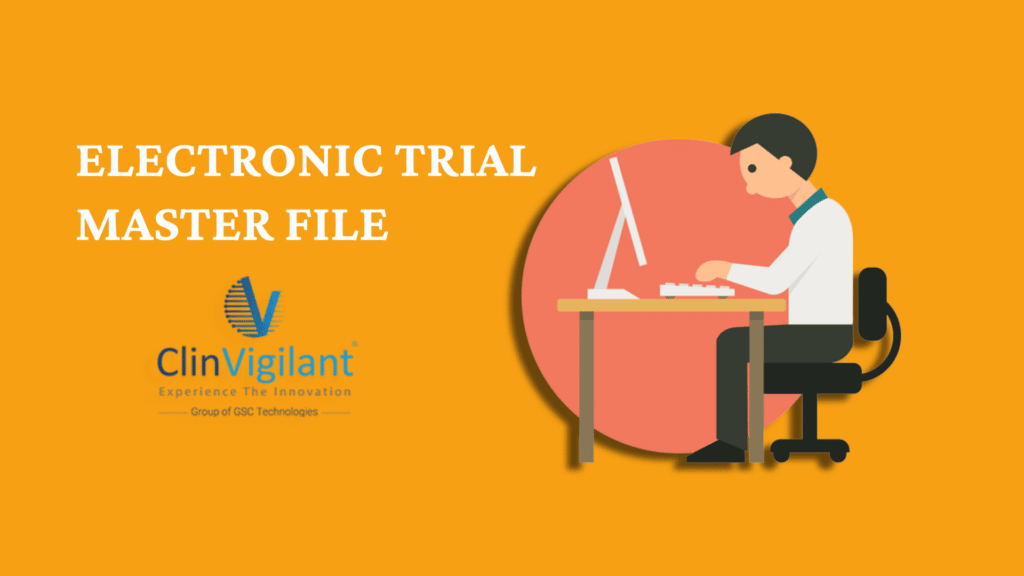The management of clinical trial documents and data is a crucial aspect of running efficient and compliant trials. Paper-based systems have significant limitations – they are cumbersome to manage, prone to errors, and lack real-time visibility. This is why electronic Trial Master Files (eTMFs) have become the preferred choice for streamlining clinical trials in the digital age.

In this blog, we will understand what eTMFs are, their benefits and challenges, how to choose the right eTMF system, and why ClinVigilant’s eTMF can be the ideal choice for your digital trials.
Understanding eTMF
An electronic trial master file (eTMF) is a digital version of the paper trial master file in clinical research that contains all essential documents related to a clinical trial. The eTMF allows for organized collection, storage, tracking, and archiving of trial documents in a secure electronic system, improving efficiency and collaboration compared to paper TMFs. Key benefits of eTMFs include remote access for authorized users, robust search capabilities, automated workflows, real-time tracking of completeness, and maintaining detailed audit trails.
eTMF systems must meet regulatory requirements such as 21 CFR Part 11 and EU Annex 11 to ensure proper controls, security, and data integrity. Overall, eTMFs streamline clinical trial documentation management, providing sponsors and sites a centralized compliant repository to store, manage, and share trial records throughout the study lifecycle.
Purpose and Role
An eTMF refers to a centralized electronic system to store, manage, and archive all TMF clinical trials content across clinical trials. It is the core repository for all trial-related documents – protocols, ethics committee approvals, regulatory submissions, safety reports, monitoring reports, and more.
At its core, an eTMF serves four key purposes:
- Centralized document storage and version control
- Structured document categorization and indexing
- Collaboration platform across teams/sites
- Audit-ready archive for inspections
Components
A robust eTMF software has four integral components:
- Document Management System (DMS) – To store, categorize, search documents
- Role-based Access Control (RBAC) – Manages user access
- Audit trail – Complete chain-of-custody for documents
- Reporting and Analytics – Insights through reports and dashboards
The Evolution of eTMF in Clinical Trials
eTMF adoption has steadily increased over the past decade with the growth of digital systems in trials. The COVID pandemic further accelerated eTMF implementation with remote trials. Globally, over 65% of trials now utilize eTMFs and this is expected to grow to 90% by 2025. eTMFs integrate seamlessly with e-clinical suites creating one connected ecosystem for clinical trials.
Benefits of eTMF in Clinical Trials
eTMF delivers numerous operational efficiencies and cost savings for clinical trials, such as:
- Real-time visibility into TMF in clinical research documents for faster decision making
- Structured templates ensurfe consistency in TMF content
- Easy collaboration across global study teams through shared access
- 30-50% faster TMF finalization at trial closure
- Accelerated study startup by allowing parallel ethics submissions
- Audit-ready document archive reduces inspection risks
- Reduces paper costs and document shipping by 90%
Additionally, eTMF also enables advanced analytics through reports and dashboards providing proactive insights. Metrics on submission status, quality of documents, turnaround times help continuous improvement.
Challenges and Solutions in Managing eTMFs
However, as trials get more complex, managing eTMF data can pose some key challenges:
Data Migration
Legacy trial data may be dispersed across emails, file shares, paper archives making migration to the eTMF platform cumbersome. An advanced EDC-eTMF integration can automatically port existing EDC documents saving significant effort.
Managing Multiple Trials
Studies may use disjointed eTMF systems causing data siloes and oversight challenges tracking documents across trials. Unified platform for all trials resolves this issue.
Lack of Specialized Templates
Generic document upload templates may result in wrong uploads or missing content. Role-specific smart intake forms can simplify uploads while also guiding users.
Inspection Readiness
Preparing for rigid regulatory inspections requires collating content from multiple sources into structured files. Automated inspection readiness dashboards can accelerate this process from weeks to hours.
Choosing the Right eTMF System
An eTMF system forms the backbone of clinical trials in the digital age. Selecting the right clinical trial software platform is crucial based on:
Flexibility & Control
The system allows creating customized templates, forms, fields, and workflows tailored to specific process needs across trials and teams.
Interoperability
It integrates tightly with your existing clinical trial systems like EDCs, CTMS, safety databases, central lab platforms. API integration capabilities ease data exchange.
Compliance
The software is designed keeping stringent regulatory compliance guidelines (Part 11 FDA, HIPAA etc.) related to data validations, audit trail, reports, system access, and so on.
Analytics-driven Insights
Actionable analytics dashboards provide real-time visibility allowing proactive data quality and submission lag interventions rather than reactive measures.
Why choose ClinVigilant’s eTMF system for your clinical trials?
ClinVigilant offers one of the most flexible, intuitive and easy-to-use eTMF systems helping streamline clinical trials. Key advantages include:
- Unified platform for all trials avoids data siloes with multi-study oversight
- Optimized for mid-sized biopharma with intuitive self-serve administration
- 200+ custom fields to map existing workflows rather than adapting to rigid software
- Rule-based smart forms simplify document collection, reducing training needs
- Auto-stitching of content from emails / EDC using advanced intelligence
- Inspector dashboard collates audit-ready content from multiple sources
- Metrics-driven analytics identifies bottlenecks across the submission process
- Experienced 24×7 onshore customer success team provides hands-on support
ClinVigilant helps mid-sized biopharma extract more value from their eTMF investment through flexibility and analytics while maintaining compliance. This allows focusing resources on innovation rather than technology management.
Conclusion
eTMFs will continue to gain rapid adoption as the biopharma industry undertakes digital transformation initiatives. Selecting the right eTMF platform tailored to specific needs is key to maximizing value while minimizing risks. If managed well, eTMFs can accelerate trials by 30-50% through real-time document accessibility and metrics-driven improvements.
FAQs
Q: Can eTMF software manage both digital and physical content?
Yes, advanced hybrid TMF clinical research systems allow uploading digital documents as well as tracking physical documents, samples, and inventory.
Q: Does every site in a multi-site trial need access to the eTMF?
While select document access can be given to site teams, uploading or modifying permissions are usually restricted only for the sponsor team.
Q: How long should documents be archived in the eTMF?
As per regulations, eTMFs need to archive all trial documents for 25 years after trial completion before destruction.

